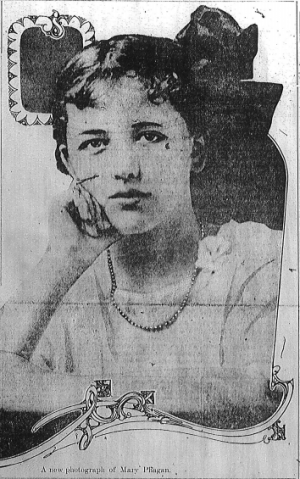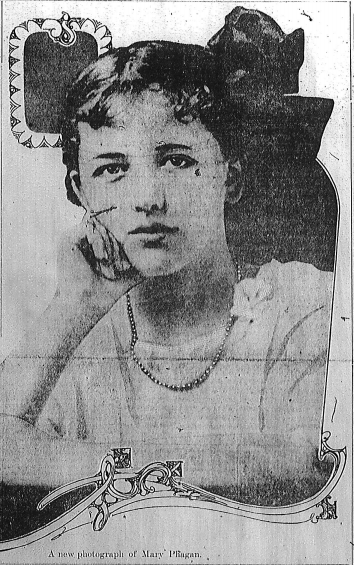
by Scott Aaron
IT MAY WELL BE the greatest murder mystery of all time. Some assert that the Mary Phagan murder case is solved, but those who so assert are of two different and mutually exclusive camps. And those two camps still stand diametrically opposed to this day, four generations later. The case aroused the outrage and ire and vengeance of two great communities. One, the Jewish community, feel overwhelmingly today, and felt to a lesser but still substantial extent in 1913, that Leo Frank was tried and condemned simply because he was a Jew. They believe that Leo Frank is so obviously innocent that he never would have been tried had it not been for endemic anti-Semitism in 1913 Atlanta. And they have been remarkably effective in making Southern anti-Semitism the leitmotif of virtually all drama, documentary, and other remembrance of this case for the last half century. The other, the largely Christian Southern gentile community, believed overwhelmingly in 1913 — and to an unknown but doubtlessly large degree still believes today — that justice was done when all the jurors, and every appeal court in the land including the Supreme Court of the United States, after a monumental and impressively-funded defense, agreed that Leo Frank was fairly tried and convicted for the murder of Mary Phagan. And it must rankle Southerners almost beyond words to be accused of anti-Semitism, when no Christian community anywhere on earth has so respected and welcomed Jews, has so openly acknowledged its spiritual roots in Judaism, or has so enthusiastically supported the Jewish state of Israel.

It all begins with Mary Phagan, a sweet and lovely 13-year-old girl on the threshold of womanhood. She was loved and treasured by those who knew her well. When her all-too-real tragedy began, she had just played the part of Sleeping Beauty in a church play (and, her family tells us, was unable to stop giggling during the rehearsals of the kissing scene). Barely a teenager, she was nevertheless providing support to her family – at the wage rate of seven and a half cents an hour (see Gannt testimony, coroner’s inquest) – working as a child laborer in the sweatshop of Atlanta’s National Pencil Company.
Late on Saturday morning, April 26, 1913, brightly dressed for the parade and festivities that were to take place that afternoon to celebrate Confederate Memorial Day, Mary Phagan went to pick up her pay of $1.20 from factory superintendent and part-owner Leo Frank. Frank was a businessman who was so well-respected in Atlanta’s very successful Jewish community that, at the age of 29, he had become the president of the local chapter of B’nai B’rith.

Mary Phagan never made it to the parade. Her bloody body was found at three o’clock the next morning in the factory basement, brutally used, beaten, and strangled to death. The sudden end of Mary Phagan’s brief life shocked Atlanta, then the entire South, and ultimately the entire nation.
Her death became the center of intense public outrage and interest, and Frank was charged with her murder. Jewish businessmen, publishers, and organizations from all over the country made Frank’s defense a cause célèbre, and the large sums donated enabled Frank to procure the most respected lawyers in the state and even to appeal his case to the highest court in the land. But to little avail – ultimately Leo Frank was found guilty of the unspeakable killing of little Mary, and his appeals were rejected by every court that heard them.
Frank was sentenced to hang, to much public satisfaction. But in 1915 John Slaton, the state’s outgoing governor, under tremendous pressure from both sides, made the decision during the last moments of his administration to commute Frank’s sentence to life in prison – despite the fact the he, Slaton, was a senior partner in the law firm that defended Frank.

Outraged by what they saw as corruption and a miscarriage of justice, a group comprising some of the region’s leading citizens laid careful plans to abduct Frank from his prison cell and carry out the jury’s original sentence of hanging – and they did so, lynching him not far from Mary Phagan’s home.
It is this second horrific death by strangulation – Leo Frank’s – that occupies the public mind today. Frank, not Mary Phagan, is the locus of tragedy, of moral lessons, of outrage and mourning. Mary Phagan’s life, and the horrors she endured in her last moments, are almost forgotten except as a backdrop for Frank’s persecution and death at the hands of alleged anti-Semites. Her tragedy, and her family’s grief and outcry for justice, have been turned into little more than footnotes.

I said there were three strangling deaths. The third is the strangling to death of the truth. Much of the real history of this case, and the actual, primary evidence that was brought to light at the time, is almost unknown today – at least to that vast majority who consume the academic works, popular dramatizations, articles, and books that have addressed the subject of Leo Frank in recent decades. Instead of real history, investigated and recounted with a deep commitment to objectivity, we are given a simplistic, moralistic narrative of an obviously innocent Leo Frank victimized by bigoted anti-Semites who subjected him to a sham trial and an horrific lynching – with the added fillip that the undoubted killer was an African-American, Jim Conley, who was never prosecuted because anti-Semitic fervor demanded Frank’s blood. This narrative is such an imposture that not even the honorable supporters of Leo Frank in 1913, were they alive today, would recognize or endorse it. It is a farrago of emotional blackmail, half-truths, omissions, and outright hoaxes. I write so that the readers and students of today can at long last see that, whatever prejudices there may have been in 1913 Atlanta, those that prevail in the mediasphere of 2013 are far worse.

This sham history will collapse, sooner or later, as new generations of investigators rediscover the evidence that has been brushed under the rug in recent years. Young historians, some of them not yet born, will make their reputations and earn their doctorates exposing the hoaxes that now seem to buttress (but will ultimately undermine) the false narrative. Will this rediscovery of the truth cause a backlash of real anti-Semitism against Southern Jews or Jews in general? I think not. Just because a few soi-disant leaders, cranks, and self-promoters palmed off their paranoiac vision of the Frank case on a generation is no reason for a real vendetta. I intend to show that a middle path that respects truth above ethnic and religious loyalty is needed, and Jewish voices should be prominent in leading the way if we are to avoid another swing of the knife-edged pendulum of hate.

One of the most remarkable things I discovered when writing this book was that many of the original articles about this case – even major ones – and affidavits, sworn statements, and utterances of great import from the central participants in the case, were not available online, not searchable, not findable, not even readable. That is, until a courageous man named Mark Cohen, almost 100 years after the fact, scanned in and uploaded nearly all the relevant contemporary newspapers, magazines, and surviving trial materials to his Web site, leofrank.org. I deeply appreciate Mr. Cohen’s efforts in doing this service for us, for our posterity, and for history. (I do not, however, endorse all of Mr. Cohen’s theories of, or conclusions about, this case.) It was a monumental effort that must have taken years. Even then, though, the material was largely not searchable because most of the fragile, faded papers from which the uploaded PDF files had been made were not of good enough quality to allow them to be turned into text using OCR technology. So, to provide the most important evidence to you, the reader, in this book I found myself retyping – and, as I typed, reliving – the events of 100 years ago exactly as they were reported at the time.

What was available to the researcher about the Frank case – and to the reader and student – was practically all derivative writing, mostly decades removed from the events, and with minuscule exceptions all slavishly devoted to the received narrative of Frank’s absolute innocence and pervasive Southern anti-Semitism.
For many, the evidence against Leo Frank could not pass the test of “beyond a reasonable doubt.” I am not sure that I could have authorized the opening of the trap door beneath him myself. But, to the jury which tried him, it did pass that test. The judge rightly charged the jury to throw aside all preconceptions and prejudices and judge the case on the evidence alone. We should do the same. In this book I have, for the first time since 1913, provided the background that allows us to do so. I have presented, largely as the people of Atlanta would have seen it, the case against Leo Frank.

If we cannot open our eyes to see what the people of that time and place saw, if we dare not examine the evidence for ourselves and throw aside the distorting lens of the media’s current depiction of the case, then we are indulging ourselves in feel-good (or, for many, feel-bad) fiction. If we do that in the Frank case – a case in which the received narrative is one of blood libel against an entire people and culture – we have abandoned responsibility for our children’s future and any shred of honor we might once have possessed.
I have spent most of my life in the South, and learned much from its people. All of us, Jew and Gentile, black and white, deserve better. We should respect the truth above all. Lying to right a perceived wrong is compounding the wrong, prolonging and augmenting the hate we claim to oppose.
Scott Aaron
Atlanta, Georgia
* * *
Source: LeoFrank.info
